Top Four Reasons to Travel to Bordeaux!
December 6, 2024
Bordeaux is well known for being the wine capital of the world, and with good reason. Bordeaux produces at least 400 million liters of -…
Read This Post I love to travel, and I especially love to travel to Italy. I’ve described elsewhere why Rome is my favorite, and perhaps no other neighborhood beckons to me like Trastevere. Trastevere literally means “across the Tiber” (Tevere is the name of the Tiber River in Italian). It’s a very descriptive name, as it is the part of Rome that likes just across the Tiber from the historical center. Known for its funky, bohemian atmosphere, it has gone from a centuries-old working class neighborhood to one of the most hippest tourist spots. It is full of trattorias, pubs, artisan shops, and wine bars, making it one of the best places to head for an evening out with friends.
I love to travel, and I especially love to travel to Italy. I’ve described elsewhere why Rome is my favorite, and perhaps no other neighborhood beckons to me like Trastevere. Trastevere literally means “across the Tiber” (Tevere is the name of the Tiber River in Italian). It’s a very descriptive name, as it is the part of Rome that likes just across the Tiber from the historical center. Known for its funky, bohemian atmosphere, it has gone from a centuries-old working class neighborhood to one of the most hippest tourist spots. It is full of trattorias, pubs, artisan shops, and wine bars, making it one of the best places to head for an evening out with friends. 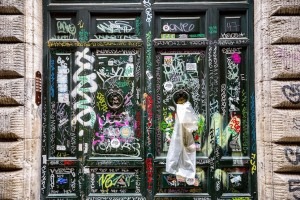 Most pictures you see if Trastevere capture the winding, cobblestone streets and medieval feeling of the neighborhood, but few capture the, well, seediness of it. It is a safe neighborhood, but you’ll find plenty of graffiti and grime to keep things real. Trastevere has an undeniably youthful vibe. Whether you are exploring one of the colorful piazzas, indulging in some of the best pizza in Rome, or contemplating the stunning art in its beautiful churches, Trastevere has plenty to delight the savvy traveler.
Most pictures you see if Trastevere capture the winding, cobblestone streets and medieval feeling of the neighborhood, but few capture the, well, seediness of it. It is a safe neighborhood, but you’ll find plenty of graffiti and grime to keep things real. Trastevere has an undeniably youthful vibe. Whether you are exploring one of the colorful piazzas, indulging in some of the best pizza in Rome, or contemplating the stunning art in its beautiful churches, Trastevere has plenty to delight the savvy traveler.
 Things to Do in Trastevere
Things to Do in TrastevereAt the top of my list of things to do in Trastevere is a foodie walking tour. We offer a wonderful Rome food tour that takes you through the neighborhood and allows you to taste not only some of Rome’s most iconic foods but some of its best kept secrets. From pizza al taglio to supplì, from gelato to maritozzi, you will find ample delights on our Rome food tour.
 2) Piazzas
2) Piazzas One of the most vibrant parts of Trastevere – and of all of Rome – are the piazzas. Head to Piazza di Santa Maria in Trastevere for a stroll and you will find street performers, artists, musicians, and craftspeople selling their wares. We once watched, enthralled, as an artist created landscape paintings with spray paint before our eyes. My young son was so enraptured, the artist gifted him a painting (pictured).  But even if you don’t take anything home, just experiencing the lively artistic scene will make it worth your visit. If you head to the Piazza Trilussa, just in front of the famous Ponte Sisto, you can sit on the steps of the piazza’s fountain and enjoy the evening with the Roman youth that congregates there.
But even if you don’t take anything home, just experiencing the lively artistic scene will make it worth your visit. If you head to the Piazza Trilussa, just in front of the famous Ponte Sisto, you can sit on the steps of the piazza’s fountain and enjoy the evening with the Roman youth that congregates there.
Two of my favorite churches in all of Rome are in Trastevere: the Basilica di Santa Maria in Trastevere and the Basilica di Santa Cecilia in Trastevere.  Santa Maria in Trastevere The Basilica di Santa Maria in Trastevere is one of the oldest churches in Rome, and one of the oldest Christian churches period. Its roots go back to the Fourth Century – and yes, that is Fourth, not Fourteenth! – while most of what remains today was constructed in the Twelfth Century. The Thirteenth-Century mosaics by Pietro Cavallini are breathtaking. The arcade, the bell tower, and the way it is set off and slightly to the side of the piazza give it one of the most recognizable exteriors for a minor basilica. The interior includes more medieval mosaics featuring depictions from the life of Mary, as well as Ionic and Corinthian columns that were taken from the ruins of the Baths of Caracalla. While you’re there, don’t forget to look up. The octagonal ceiling painting by the famed artiist Domenichino will reward your efforts. Basilica di Santa Cecilia
Santa Maria in Trastevere The Basilica di Santa Maria in Trastevere is one of the oldest churches in Rome, and one of the oldest Christian churches period. Its roots go back to the Fourth Century – and yes, that is Fourth, not Fourteenth! – while most of what remains today was constructed in the Twelfth Century. The Thirteenth-Century mosaics by Pietro Cavallini are breathtaking. The arcade, the bell tower, and the way it is set off and slightly to the side of the piazza give it one of the most recognizable exteriors for a minor basilica. The interior includes more medieval mosaics featuring depictions from the life of Mary, as well as Ionic and Corinthian columns that were taken from the ruins of the Baths of Caracalla. While you’re there, don’t forget to look up. The octagonal ceiling painting by the famed artiist Domenichino will reward your efforts. Basilica di Santa Cecilia 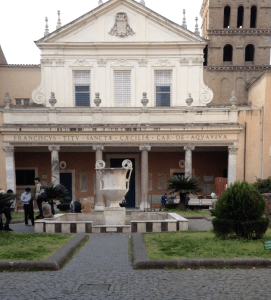 The Basilica di Santa Cecilia is a Ninth-Century church founded on the site of an earlier, Fifth-Century shrine, in what I call the “quiet” part of Trastevere. The large boulevard called Viale di Trastevere bisects the neighborhood. Everything to the northwest side of it is vibrant, bustling, and sometimes crowded; the ares to the southeast is more residential, subdued, even bourgeois. At the center of this part of the neighborhood is the Basilica di Santa Cecilia in Trastevere. Cecilia was a Roman virgin martyred around 230 AD in a particularly gruesome way. The story I was told when I was lucky enough to visit the excavations under the basilica, where legend has it the saint lived, was that she was first sentenced to die by suffocation in her own bath, which was heated to excessive temperatures, but she miraculously survived. She was then sentenced to beheading, but, when the executioner had struck her on the neck by a sword (or an axe, depending on who tells the story) three times, she was still not beheaded. By law he was allowed only three attempts, so the executioner then fled, and she was left to languish for three days before she died. The church has been an active Benedictine Convento (Monastero in Italian) for centuries, and if you hang around you can hear the nuns chant Lauds, Terces, Sexts, and Vespers at the appropriate times of the day (you can see the schedule here).
The Basilica di Santa Cecilia is a Ninth-Century church founded on the site of an earlier, Fifth-Century shrine, in what I call the “quiet” part of Trastevere. The large boulevard called Viale di Trastevere bisects the neighborhood. Everything to the northwest side of it is vibrant, bustling, and sometimes crowded; the ares to the southeast is more residential, subdued, even bourgeois. At the center of this part of the neighborhood is the Basilica di Santa Cecilia in Trastevere. Cecilia was a Roman virgin martyred around 230 AD in a particularly gruesome way. The story I was told when I was lucky enough to visit the excavations under the basilica, where legend has it the saint lived, was that she was first sentenced to die by suffocation in her own bath, which was heated to excessive temperatures, but she miraculously survived. She was then sentenced to beheading, but, when the executioner had struck her on the neck by a sword (or an axe, depending on who tells the story) three times, she was still not beheaded. By law he was allowed only three attempts, so the executioner then fled, and she was left to languish for three days before she died. The church has been an active Benedictine Convento (Monastero in Italian) for centuries, and if you hang around you can hear the nuns chant Lauds, Terces, Sexts, and Vespers at the appropriate times of the day (you can see the schedule here). 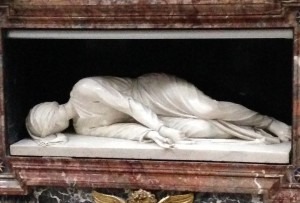 Artistically, the church has a rather unimaginative Eighteenth-Century facade, but the interior still holds some remarkable art from the Thirteenth Century, including a partially destroyed Cavallini fresco and mosaics by the same artist. The fresco is in the upper balcony and, along with the ancient excavations beneath the church, are only accessible at certain times and for a fee paid to the nuns. But the highlight of this church for me is the late-Renaissance statue by Stefano Maderno depicting the Martyrdom of Santa Cecilia. The dramatic statue presages the later theatrical works by Rome’s Baroque sculptors. In Maderno’s masterpiece, the saint lies prone and either dead or dying, the heaviness of her corporality strangely startling. Maderno swore that it was a faithful depiction of the Saint’s body as he witnessed it when her tomb was opened in 1599.
Artistically, the church has a rather unimaginative Eighteenth-Century facade, but the interior still holds some remarkable art from the Thirteenth Century, including a partially destroyed Cavallini fresco and mosaics by the same artist. The fresco is in the upper balcony and, along with the ancient excavations beneath the church, are only accessible at certain times and for a fee paid to the nuns. But the highlight of this church for me is the late-Renaissance statue by Stefano Maderno depicting the Martyrdom of Santa Cecilia. The dramatic statue presages the later theatrical works by Rome’s Baroque sculptors. In Maderno’s masterpiece, the saint lies prone and either dead or dying, the heaviness of her corporality strangely startling. Maderno swore that it was a faithful depiction of the Saint’s body as he witnessed it when her tomb was opened in 1599.
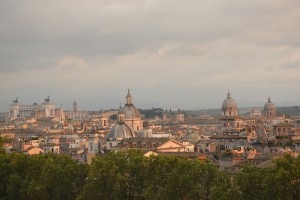 4) The Gianicolo
4) The GianicoloAt the western edge of Trastevere you will find the foot of the Janiculum Hill, called il Gianicolo in Italian. On a nice day it makes for a perfect walk and affords some of the absolute best views of Rome and the Vatican. It’s a favorite spot of Romans, particular in the summer time, when its green shady trees provide respite from the heat. Stroll around the Piazzale Garibaldi, with its large central statue of the famous general, see “Er Fontanone” (The Big Fountain, or the Fontana dell’Acqua Paola), built in part on the old Roman acquaduct, or stop in San Pietro in Montorio to see art by Vasari, del Piombo, Bernini, and others.
Trastevere has long been a favorite spot for Romans to dine. Its many long-standing osterie, trattorie and panefici are now supplemented by numerous wine bars, beer houses, and newer restaurants, but you’ll still find plenty of old Roman charm.
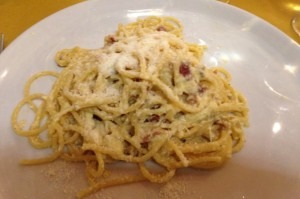 Location: Vicolo de’ Renzi, 15, 00153 Roma RM, Italy Perhaps my favorite place to eat in Rome, this Trastevere classic has a limited daily menu and does not take reservations. Get there a bit before it opens at 8pm and wait in line or you won’t get in, and order as soon as the server comes to the table, or you’ll miss your chance at such house specialties as ossobuco and gnocchi.
Location: Vicolo de’ Renzi, 15, 00153 Roma RM, Italy Perhaps my favorite place to eat in Rome, this Trastevere classic has a limited daily menu and does not take reservations. Get there a bit before it opens at 8pm and wait in line or you won’t get in, and order as soon as the server comes to the table, or you’ll miss your chance at such house specialties as ossobuco and gnocchi.
Location: Via del Moro, 15, 00153 Roma RM, Italy This little bakery in the Trastevere neighborhood is good for everything from pizza rustica (also called pizza al taglio) to bread.
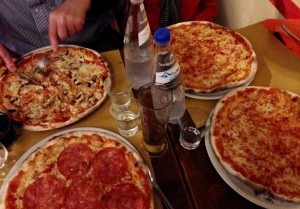 Location: Piazza di S. Calisto, 11, 00153 Roma RM, Italy Located in the heart of Trastevere, I like this spot for pizza.
Location: Piazza di S. Calisto, 11, 00153 Roma RM, Italy Located in the heart of Trastevere, I like this spot for pizza.
Location: Via della Lungaretta, 156, 00153 Roma RM, Italy This modest family-run osteria serves great traditional Roman fare like pasta alla carbonara. It’s in the “quiet” side of Trastevere, not far from the Basilica di Santa Cecilia.
 How to Get to Trastevere
How to Get to TrastevereThere are no subway stops in Trastevere, so unless you want to walk up from B line stop Piramide, you’re better off taking a bus or tram. The H bus goes from the main train station to Trastevere, and the 8 tram runs through the Viale di Trastevere.
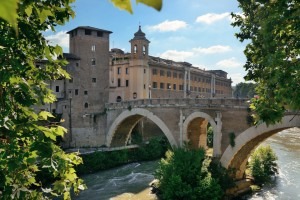 2) On foot
2) On footHowever, the best way to get to Trastevere in my opinion is to walk from the historical center. You can pass over the beautiful Ponte Fabricio, the oldest working bridge in Rome – and perhaps in the world! It was constructed in 62 BC, and has been in use ever since. From there you cross the Isola Tiberina (Tiber Island – perhaps even stopping for a gelato at the wonderful gelateria there), and then the reconstructed Ponte Cestio before arriving in Trastevere. By Peg Kern Find out more about our cooking vacations and one day cooking classes. Find more photos, videos, food facts, and travel stories from The International Kitchen on Youtube, Facebook, Instagram, Pinterest, Twitter. Sign up to receive our newsletter, which includes travel tips, recipes, promotions, and information on our best cooking vacations and food and wine tours.